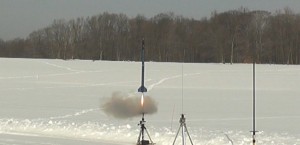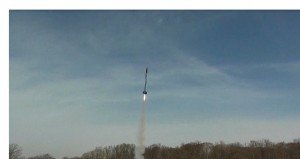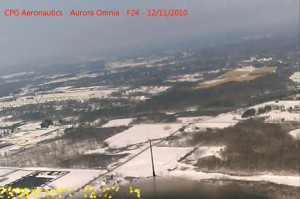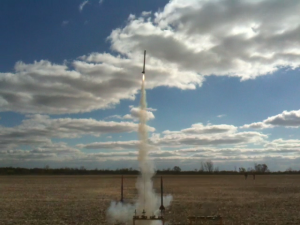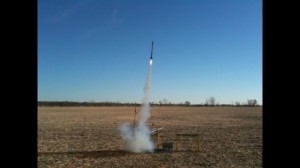| X4 Booster Flight Log |
|||||
| X4-01 – Eagle | |||||
| X4-02 – Columbia | |||||
| X4-03 – Zephyr | |||||
| X4-04 – (Ground Test Mockup) |
|||||
| Date | Mission | Vehicle | Mission Notes | Engine | Location |
| August 14, 2010 |
PLS-01 | X4-01 | Maiden Voyage | D12-5 | Harmon |
| August 14, 2010 |
PLS-02 | X4-02 | Maiden Voyage | D12-5 | Harmon |
| August 14, 2010 |
PLS-03 | X4-02 | Flight Tests | D12-5 | Harmon |
| August 14, 2010 |
PLS-04 | X4-02 | Flight Tests | E9-6 | Harmon |
| August 14, 2010 |
PLS-05 | X4-02 | Flight Tests | D12-5 | Harmon |
| August 28, 2010 |
PLS-06 | X4-02 | Payload Section Tests | E9-6 | Harmon |
| August 28, 2010 |
PLS-07 | X4-02 | Payload Section Tests | E15-7 | Harmon |
| August 28, 2010 |
PLS-08 | X4-02 | Payload Section Tests | E9-6 | Harmon |
| August 28, 2010 |
PLS-09 | X4-02 | Payload Section Tests | E9-6 | Harmon |
| September 10, 2010 |
PLS-10 | X4-02 | Payload Test | D-12-5 | Harmon |
| PLS-11 | X4-03 | DDM test | E-15 | Harmon | |
| PLS-12 | X4-03 | DDM test | E9-6 | Harmon | |
| September 11, 2010 |
PLS-13 | X4-01 | D12-5 | Harmon | |
| PLS-14 | X4-01 | E9-6 | Harmon | ||
| October 9, 2010 |
PLS-15 | X4-01 | Camera | E9-6 | Harmon |
| PLS-16 | X4-01 | Camera | E9-6 | Harmon | |
| PLS-17 | X4-01 | Camea | E9-6 | Harmon | |
| PLS-18 | X4-02 | Camera | D-12-5 | Harmon | |
| PLS-19 | X4-02 | Camera | D-12-5 | Harmon | |
| October 23, 2010 |
PLS-20 | X4-02 | Payload / Alt1 | D12-5 | Harmon |
| PLS-21 | X4-02 | Camera / Alt1 | D12-5 | Harmon | |
| November 6, 2010 |
PLS-22 | X4-03 | SM Camera | E9-6 | Dayton |
| PLS-23 | X4-03 | SM Camera | E9-6 | Dayton | |
| PLS-24 | X4-02 | Camera | E18-7 | Dayton | |
| PLS-25 | X4-02 | Camera | E18-4 | Dayton | |
| November 7, 2010 |
PLS-26 | X4-01 | Camera | E18-7 | Dayton |
| PLS-27 | X4-01 | Camera | F24-7 | Dayton | |
| PLS-28 | X4-02 | Camera | F24-7 | Dayton | |
| December 11, 2010 |
PLS-29 | X4-01 | SM Camera | E9-6 | Harmon |
Archive for XR4 (Perseus) Medium Power Booster project
(Ray Harmon flying field – Aurora, OH. Dec. 11, 2010)
Aurora X5 Omnia, and Perseus X4 “Eagle” had successful flights this past Saturday (Dec. 11).
Omnia’s first mission of the day was a flight test of a night launch beacon system. The purpose was to fly the first of three daytime flight tests to ensure our lighting electronics systems can survive the rigors of model rocket flight dynamics & stresses.

Aurora X5 Omnia lifting off on mission AU-08, carying the night lighting system for a daytime flight test...
This flight test was launched using the Estes E9-6 motor, and was successful. All of the associated electronics performed as expected.
The next flight test for this night time lighting system is penciled in for sometime in March 2011.
The Aurora X5 Omnia was launched a second time. In this second launch, Omnia was carrying the good ‘ol rocket camera to capture aerial video of the Harmon field in the winter from 1158 feet. This flight was on the Aerotech F24 motor…our highest power flight from this field!
Perseus X4 Eagle made the last launch of the day with the second flight test of the booster mounted rocket camera. Its flight was also successful, and lots of useful data was obtained…as well as neat video! One important piece of information gained from this flight is the need to fly with shorter delays when using the longer configuration for the rocket on E9 motors! We had a small zipper on the parachute bay as a result of an approximately 2 extra seconds of freefall after reaching apogee before parachutes were deployed.
Our next planned launch is scheduled for sometime in February. On the agenda for that day will be the maiden voyage of the Aurora X5 “Firefly”.
The Firefly’s first mission of that day will be a flight test launch. The next mission for “Firefly” is planed be to test the responsiveness of our dual deploy recovery system electronics. This involves powering up the dual deployment system, and having it activate buzzers at apogee and at the programmed altitude to deploy the main recovery parachute. This information will be added to other flight data, and it will assist us in the design of our first mid power dual deployment system.
The first dual deployment flight is set to happen sometime in the late winter / early spring.
We will have more news on our rocket programs and missions to post soon!
((( )))
(November 6 – 7, 2010 – Springfield, OH)
The Perseus X4 boosters “Columbia” and “Eagle” flew majestically on high power flights at the Team Ohio Rocketry Club (TORC) 2nd annual gathering in Springfield, OH.
The last couple of attempts, first with “Columbia”, and secondly with “Zephyr” on an Aerotech E-15 avoided certain disaster after liftoff. Columbia “torqued” right after leaving the pad causing a kink int he airframe, which was later repaired, and Zephyr doing a loop at a similar point. It was determined that the lower launch lug was catching on the launch rod, causing disruption int he flight patterns under higher impulse liftoffs.
By mid afternoon November 6th, Columbia roared to the sky on step #1 above the E-9 barrier. on the Aerotech E-18 White lightning motor. Two flights were flown on the E-18 motor. Altitude reached was 1084 feet the first flight, 1184 the second.
After that, it was time to test the Aurora X5 booster design under similar conditions. Omnia was prepared for flight. I was feeling confident after two successful flights of Columbia on the E-18 motor that the launch lug issues were solved. So the decision was made for a “GO” at the highest power possible on our current mid power boosters. The F-24 White lightning.
Omnia flew two textbook wonderful flights on the F-24 motor, with a picture perfect flame.
Both my iPhone camera and the camera aboard Omnia captured the moment nicely.
httpv://www.youtube.com/watch?v=YuGd-nMVbTU
Omnia reached an altitude of 1024 feet the first flight — along with a VERY early parachute deployment, and 1329 feet the second flight.
November 7th was the moment of truth for the Perseus boosters. both Eagle and Columbia were scheduled for their first flights on the F-24 motor.
Eagle flew two higher power flights. The First of these flights was on the Aerotech E18-7, and reached an altitude of about 1100 feet. The second was on the F24-7. It was a great flight, but Eagle suffered a upper airframe zipper at parachute deployment after reaching an altitude of 1386 feet.
Columbia flew our last flight of the day with mission # PLS-23 on the F24-7 motor with a picture perfect flight, and reaching an altitude of 1335 feet.
httpv://www.youtube.com/watch?v=APoPhyGdN_I
All around, it was a VERY productive day of launching for us @ TORC Fest II. We have lots of videos from our launches TORC Fest on You Tube. Just do a search for our channel called “CPG Aerospace” and you’ll be all set!
((( )))
